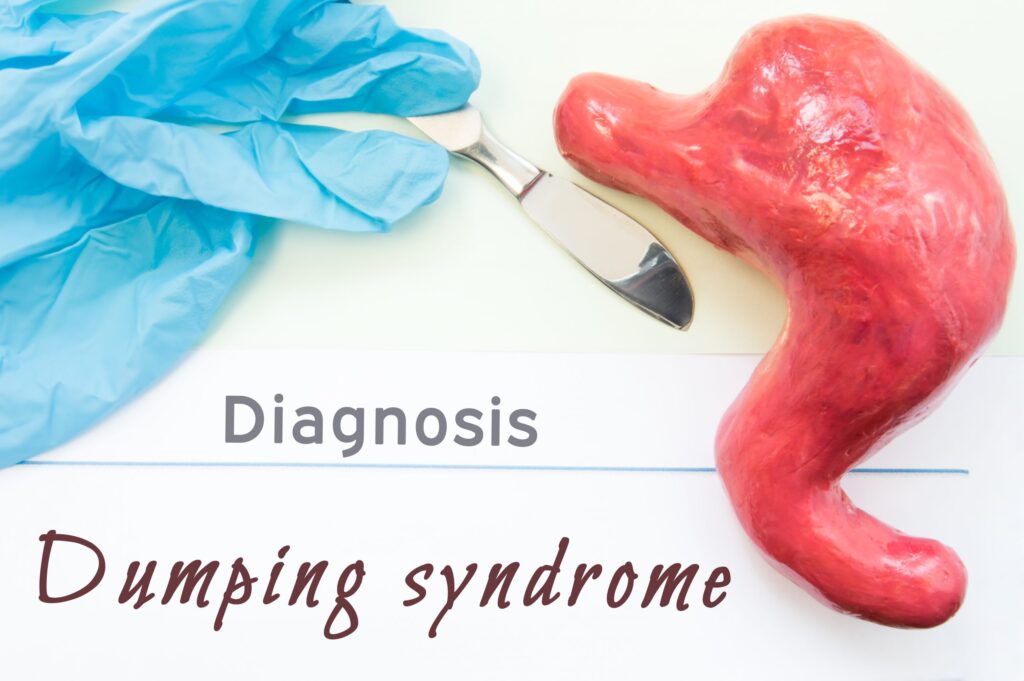Dumping syndrome is a term used to describe a group of symptoms that occur when food, especially sugar, moves too quickly from the stomach into the small intestine. This condition typically arises after gastric surgery, particularly procedures such as gastric bypass or gastric sleeve surgeries, but can also occur due to other gastrointestinal issues. Understanding the symptoms, causes, and treatment options is crucial for those who are managing this condition to improve their quality of life.

What Is Dumping Syndrome?
Dumping syndrome occurs when food, particularly high-sugar food, empties rapidly from the stomach into the small intestine. This fast-moving process overwhelms the small intestine, leading to a cascade of uncomfortable symptoms. It is categorized into two phases:
- Early Dumping Syndrome: This occurs within 10 to 30 minutes after eating. It is marked by symptoms such as nausea, dizziness, rapid heart rate, and diarrhea.
- Late Dumping Syndrome: This happens 1 to 3 hours after eating. Symptoms include weakness, confusion, and a sense of extreme hunger due to the body’s rapid release of insulin.
Understanding both phases and their symptoms is essential for managing and diagnosing the condition effectively.
Symptoms of Dumping Syndrome
The symptoms of dumping syndrome can vary in intensity and timing, but they are often related to the body’s inability to process food at a normal rate after gastric surgery. These symptoms can be categorized into early and late dumping phases:
Early Dumping Syndrome Symptoms:
- Nausea and Vomiting: Common signs shortly after eating, particularly with high-sugar or fatty foods.
- Dizziness or Lightheadedness: Caused by rapid changes in blood sugar levels and the body’s response to the food entering the small intestine too quickly.
- Abdominal Cramps and Bloating: A result of the intestine reacting to the sudden influx of food.
- Diarrhea: This can occur shortly after eating due to the body’s inability to properly digest food in such a short time frame.
Late Dumping Syndrome Symptoms:
- Hypoglycemia (Low Blood Sugar): Occurs when the body releases too much insulin in response to a high-carb meal, leading to symptoms such as sweating, shaking, and confusion.
- Extreme Fatigue and Weakness: This often follows an episode of hypoglycemia.
- Hunger or Cravings: Occurs due to the body’s attempts to correct the low blood sugar levels.
Both phases can significantly impact daily life and make meal planning and consumption difficult.
Causes of Dumping Syndrome
The primary cause of dumping syndrome is related to the surgical alterations made to the stomach, such as those from gastric bypass or other weight loss surgeries. These changes speed up the process of digestion, which, when not managed properly, leads to the rapid movement of food into the small intestine. However, other causes may include:
- Gastric Surgery: Procedures like gastric bypass, sleeve gastrectomy, or partial gastrectomy can alter the normal digestive process and result in dumping syndrome.
- Gastroparesis: A condition where the stomach takes too long to empty its contents, which may also contribute to rapid gastric emptying.
- Gastrointestinal Disorders: Conditions such as peptic ulcers or certain types of infections can sometimes trigger the onset of dumping syndrome.
It’s essential to recognize these triggers to prevent or manage symptoms effectively.
Diagnosis of Dumping Syndrome
Diagnosis typically involves a thorough medical history and a physical exam. Your doctor may ask questions about the symptoms you experience after eating and may request additional tests such as:
- Blood Tests: To check for abnormal blood sugar levels after eating.
- Breath Tests: To assess how quickly food moves through the digestive tract.
- Gastric Emptying Studies: To track the speed at which food empties from the stomach into the small intestine.
A proper diagnosis is key to tailoring treatment strategies and ensuring effective management.
Treatment Options for Dumping Syndrome
Managing dumping syndrome often requires a combination of dietary changes, medications, and in some cases, surgical interventions. Below are some common treatment strategies:
1. Dietary Modifications
- Smaller, More Frequent Meals: Eating smaller meals throughout the day can reduce the symptoms by slowing down the rate at which food enters the small intestine.
- Low-Sugar Diet: Limiting high-sugar and high-carbohydrate foods is critical, as they can exacerbate symptoms of dumping syndrome.
- Increase Protein Intake: Protein-rich foods can help slow down gastric emptying and prevent hypoglycemia.
- Avoiding Fluids During Meals: Drinking too much liquid with meals can cause food to move too quickly through the stomach. It’s recommended to drink fluids between meals rather than during meals.
2. Medications
- Octreotide: This medication can help slow down gastric emptying and reduce symptoms in some individuals with dumping syndrome.
- Acarbose: This drug helps slow the absorption of carbohydrates in the small intestine, which can help prevent blood sugar spikes and the associated symptoms.
- Antidiarrheal Medications: In cases where diarrhea is a frequent issue, medications like loperamide may be prescribed.
3. Surgical Options
- Reconstruction Surgery: In rare cases, further surgery may be needed to correct the anatomical changes caused by previous weight loss surgery that contributed to the condition.
- Pyloroplasty: This procedure may be performed to widen the pylorus (the opening between the stomach and small intestine) to slow down the emptying of food.
Lifestyle Changes to Manage Dumping Syndrome
In addition to medical treatment and dietary adjustments, adopting certain lifestyle changes can further help manage dumping syndrome:
- Regular Physical Activity: Moderate exercise can help regulate blood sugar levels and improve overall gastrointestinal function.
- Monitoring Blood Sugar Levels: People with dumping syndrome should keep a close eye on their blood sugar levels, particularly after meals, to avoid hypoglycemia.
- Stress Management: Stress can exacerbate gastrointestinal symptoms, so practicing relaxation techniques like yoga or meditation may be beneficial.
The Role of Diet in Managing Dumping Syndrome
As diet plays such a pivotal role in managing dumping syndrome, understanding which foods to avoid and which foods to incorporate into meals is crucial. A dietitian specialized in gastrointestinal disorders can provide personalized meal plans. Here are some general guidelines:
- Foods to Avoid: High-sugar foods, refined carbohydrates, caffeine, and alcohol can trigger symptoms. It’s important to limit foods that cause blood sugar spikes or rapid gastric emptying.
- Foods to Incorporate: High-fiber foods, lean proteins, and healthy fats should be included. Vegetables, whole grains, and healthy fats like those found in avocados or nuts can slow digestion and reduce symptoms.
Complications of Dumping Syndrome
While dumping syndrome itself is not life-threatening, it can lead to significant health complications if not properly managed. These complications may include:
- Nutritional Deficiencies: Due to poor nutrient absorption, individuals with dumping syndrome may experience deficiencies in vitamins and minerals, leading to conditions like anemia or osteoporosis.
- Dehydration: Chronic diarrhea can lead to dehydration if fluid intake isn’t properly monitored.
- Psychological Impact: The limitations caused by the condition, including avoiding certain foods and managing symptoms, can lead to feelings of frustration or depression.

